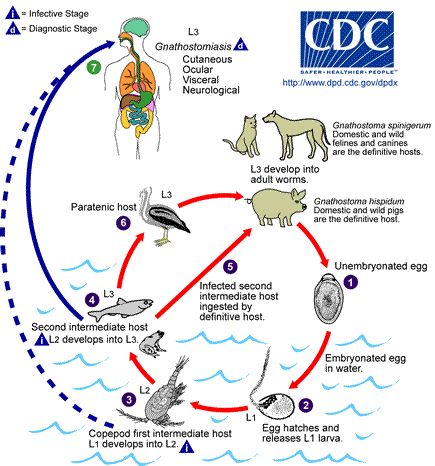| |
In the natural
definitive host (pigs, cats, dogs, wild animals) the adult worms reside in a
tumor which they induce in the gastric wall. They deposit eggs that are
unembryonated when passed in the feces
 . Eggs
become embryonated in water, and eggs release first-stage larvae . Eggs
become embryonated in water, and eggs release first-stage larvae
 . If
ingested by a small crustacean (Cyclops, first intermediate host),
the first-stage larvae develop into second-stage larvae . If
ingested by a small crustacean (Cyclops, first intermediate host),
the first-stage larvae develop into second-stage larvae
 .
Following ingestion of the Cyclops by a fish, frog, or snake (second
intermediate host), the second-stage larvae migrate into the flesh and
develop into third-stage larvae .
Following ingestion of the Cyclops by a fish, frog, or snake (second
intermediate host), the second-stage larvae migrate into the flesh and
develop into third-stage larvae
 . When
the second intermediate host is ingested by a definitive host, the
third-stage larvae develop into adult parasites in the stomach wall . When
the second intermediate host is ingested by a definitive host, the
third-stage larvae develop into adult parasites in the stomach wall
 .
Alternatively, the second intermediate host may be ingested by the paratenic
host (animals such as birds, snakes, and frogs) in which the third-stage
larvae do not develop further but remain infective to the next predator .
Alternatively, the second intermediate host may be ingested by the paratenic
host (animals such as birds, snakes, and frogs) in which the third-stage
larvae do not develop further but remain infective to the next predator
 . Humans
become infected by eating undercooked fish or poultry containing third-stage
larvae, or reportedly by drinking water containing infective second-stage
larvae in Cyclops . Humans
become infected by eating undercooked fish or poultry containing third-stage
larvae, or reportedly by drinking water containing infective second-stage
larvae in Cyclops
 . . |
|
